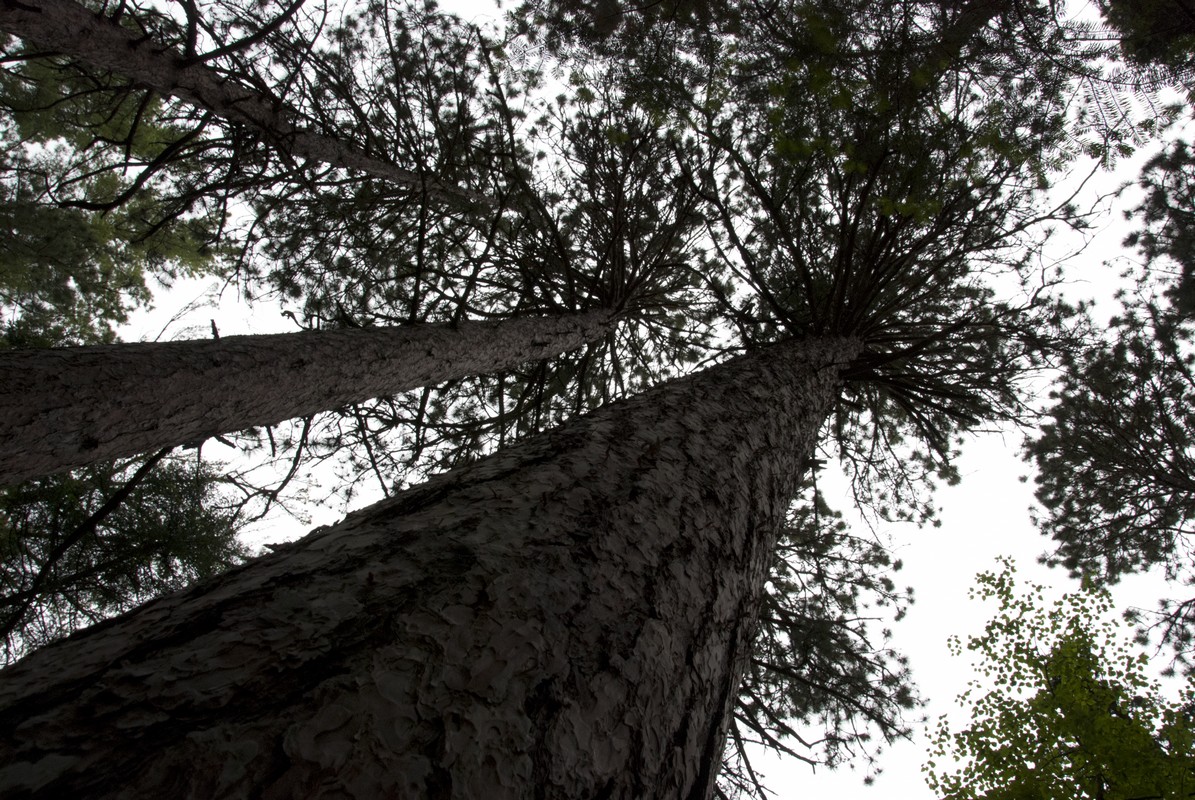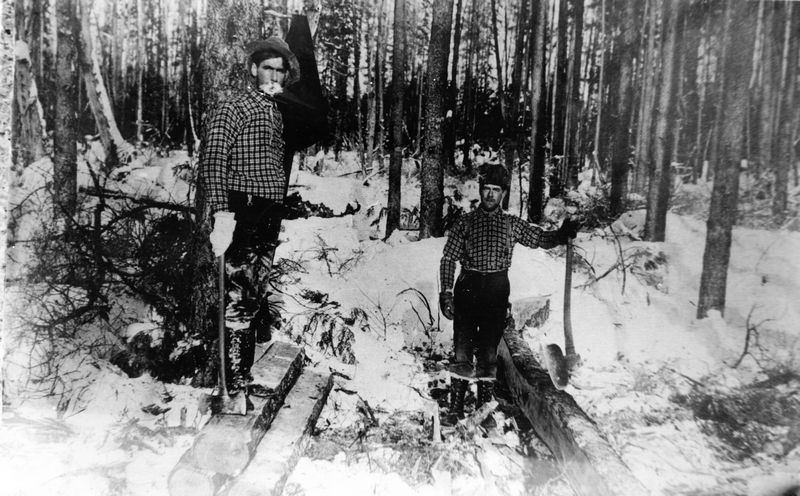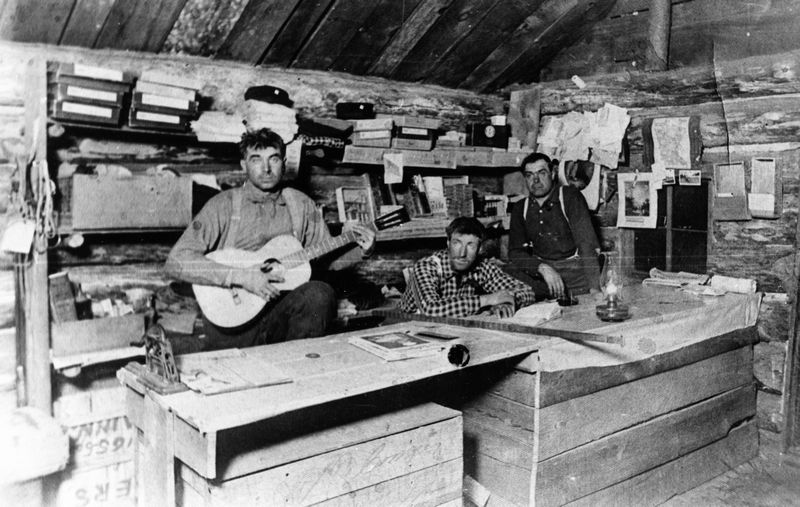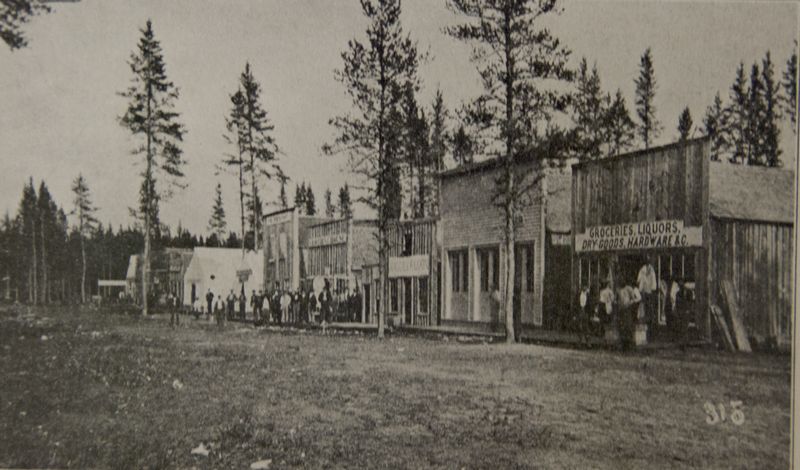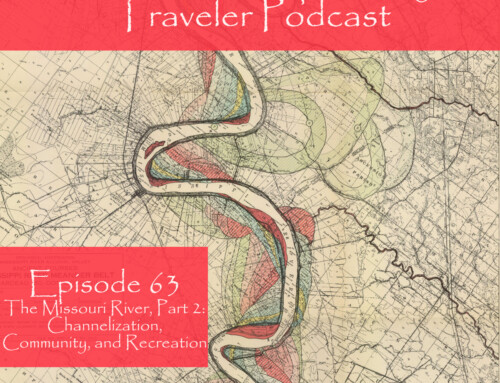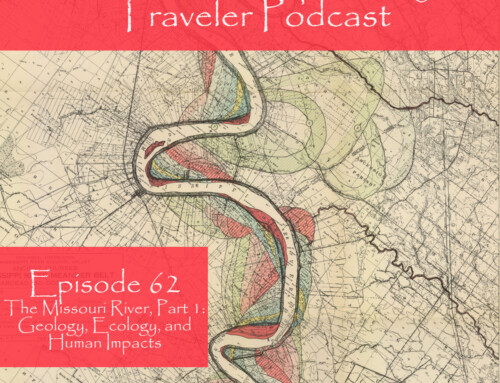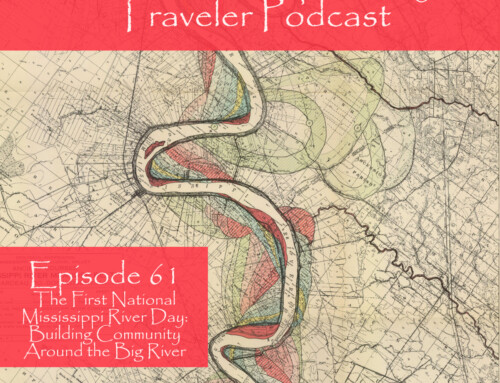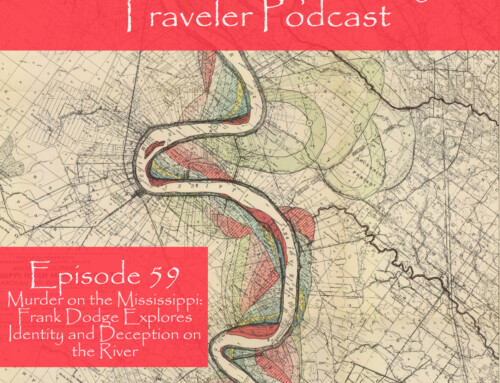Dense forests of white and red pine once ranged across northern Wisconsin and Minnesota. Tall, ancient trees that were part of a rich ecosystem well-adapted to the northern climate and one that had evolved to rely on periodic fires to stay healthy. Those trees were also highly desired by logging companies and builders who needed vast amounts of lumber to feed the appetites of growing communities in the middle part of America. In this episode, I describe what those forests were like, then get into stories from the era when those forests were leveled. I talk about the logging camps, the men who worked in them, and life in the communities that grew up around those camps. You’ll hear stories about the daily life for a logger, the speed of frontier justice, and the rapid decline of the industry. People once believed that those tall trees were a virtually infinite resource, yet almost of them were taken down in Minnesota and Wisconsin in just a couple of decades. I finish with a few thoughts on what those forests are like today. In the Mississippi Minute, I talk about a couple places where it’s still possible to walk around old growth pine forests.
Show Notes
Places to visit old growth pine forests:
Bohall Trail at Itasca State Park
Pine Grove Park, LIttle Falls, MN
The Lost 40 (Chippewa National Forest)
Support the Show
If you are enjoying the podcast, please consider showing your support by making a one-time contribution or by supporting as a regular contributor through Patreon. Every dollar you contribute makes it possible for me to continue sharing stories about America’s Greatest River.
Don’t want to deal with Patreon? No worries. You can show some love by buying me a coffee (which I drink a lot of!). Just click on the link below.
Transcript
SUMMARY KEYWORDS
logging, forest, white pine, northern minnesota, mackey, river, men, deer, trees, mississippi river, years, towns, loggers, people, burke, minnesota, fires, camp, pine, worked
SPEAKERS
Dean Klinkenberg
Dean Klinkenberg 00:00
The growing US West had a nearly insatiable appetite for wood for building houses, stores, and railroad tracks and as a fuel source. Wood from the pine forests of Wisconsin and Minnesota met much of this demand, building towns such as Minneapolis, Fargo, Omaha, even St. Louis.
Dean Klinkenberg 00:40
Welcome to the Mississippi Valley Traveler Podcast. I’m Dean Klinkenberg. And I’ve been exploring the deep history and rich culture of the people in places along America’s greatest river, the Mississippi, since 2007. Join me as I go deep into the characters and places along the river and occasionally wander into other stories from the Midwest and other rivers. Read the episode show notes and get more information on the Mississippi at MississippiValleyTraveler.com. Let’s get going.
Dean Klinkenberg 01:12
Welcome to Episode 23 of the Mississippi Valley Traveler podcast. My mind has been thinking about August. I’m working on some plans for a trip to go up north, so the northern forests have really been on my mind lately. This seemed like a good time to get into a few stories about those forests. So in this episode, I’m going to tell you a little bit about what those old forests were like before they were clear cut, and then get into the a few stories about the peak era of logging when most of those forests were clear cut. I’m going to throw in a few stories also about life in the logging camps and the communities that supported them, just because those are some good stories. And then I’m going to wrap up with a brief description of what the forests are like today. As always, thanks to those of you who show me some love through Patreon. If you want to be one of those people, go to patreon.com/deanKlinkenberg, where you will find out how you too can become a supporter. If that’s not your thing, you can buy me a coffee and support my caffeine habit. Just go to MississippiValleyTraveler.com/podcast and there’ll be instructions there for how you can buy me a coffee. And now on with the episode.
Dean Klinkenberg 02:38
I first hiked the Bohall Trail in Itasca State Park in August 2011, guided by Naturalist Connie Cox, whose broad knowledge of the landscape spilled out in a stream-of-consciousness monologue as we hiked. The trail winds and undulates through a forest dense enough to hide a bear or a wolf just a few yards from where we hiked. Dappled sunlight penetrated to the forest floor feeding plants such as large-leaved aster, beaked hazelnut, and broken ferns. The ground was covered by pine needles. Every step released a fresh burst of their scent, which I consumed greedily.
The forest is dominated by white and red pine, centuries-old trees with tufts at the top that reach a hundred feet high. Bogs and shallow lakes break up the forest’s density, revealing a wider view of the forest, as well as breeding grounds for thick clouds of mosquitoes and aggressive deer flies. As we got close to a bog, the firm topsoil gave way to a spongy surface of peat that might tolerate the weight of one average person (average by 19th century standards, anyway) but two people standing in the same spot would sink in the muck two or three feet deep, each step a laborious effort of raising their feet up and out and into the next spot of thick mud. The unlucky ones would get trapped by the viscous suction and need a hand or two to get on the way again. This is essentially what Minnesota’s pine forest was like before logging began. There are just a few places left in Minnesota where you can experience it.
In 1870, dense forests of old red and white pine and swamps of spongy peat covered the northern third of Minnesota from Lake Superior to the Dakotas. While cities along the Mississippi River further south were booming—in the previous decade, the populations of St. Louis and Memphis had doubled while New Orleans continued its steady growth—around the Headwaters of the Mississippi River in northern Minnesota, wolves still outnumbered people. Few Europeans had moved into the area and most Ojibwe had just been forced onto reservations at places like Red Lake and White Earth.
By 1890, just twenty years later, towns like Deer River, Grand Rapids, and Bemidji had been carved out of the forests and built atop the swamps. Twenty thousand men lived and worked in logging camps. Twenty years after that, the great pine forests were essentially gone, leveled to feed a relentless appetite for wood as the US expanded west. Thousands of square miles of towering pines were replaced by a barren landscape of stumps and debris that spread as far as the eye can see, which provided kindling for massive fires that occasionally erupted, sweeping away the debris, along with towns and people. Just one of these, the Cloquet Fire of 1918, burned across 1,500 square miles southwest of Duluth, destroying ten towns and killing 453 people.
As the trees disappeared, the logging companies moved further west to harvest more trees, eventually to Washington and Oregon, taking all they could with little forethought, expecting that the lands they left behind would be cleared for farming. Some of the denuded land in Minnesota was cultivated for agriculture, often sold on the cheap to former loggers. Before the land could be farmed, the stumps had to be cleared, sometimes with backbreaking labor, sometimes with back-saving dynamite. Early farmers had some success with root vegetables like potatoes and rutabagas, but farming in northern Minnesota was not the path to wealth: the soil was often sandy and rocky and the growing season short, just 120 days on average from the last frost in mid-May to the first frost in mid-September.
In places where no attempts were made to farm, the forests began to regenerate. Aspen and birch were the first to reestablish, followed by white spruce, then oak, then maple and basswood, before white pine slowly reemerges. If left alone, the pine forests could fully recover in a couple of centuries. But we can’t leave them alone. We still need wood.
Folks began to figure out other models for logging that ensured a more consistent harvest without devastating the landscape. Tax-forfeited land entered public trusts. Land was surveyed to catalog the amount and type of trees that had regenerated or been replanted. Land management rules were established that allowed only a percentage of the available trees to be logged in any given year. Remaining stands of old growth forest were protected in places like the Lost Forty and at Itasca State Park. Today, trees grow faster than they are being cut, and the few forests that we have left alone are slowly regenerating.
Logging today is still central to the economy of northern Minnesota; there aren’t a lot of other opportunities. Many small landowners make much-needed extra cash by selling their trees, and a few communities still have small mills that provide jobs, like the paper mill at Grand Rapids. In today’s forests, the mature trees are mostly aspen, balsam fir, and spruce, trees that are useful for pulpwood to make paper and wafer board to make cheap furniture—disposable products for a throw-away society. The white and red pine that once dominated northern Minnesota’s forests, prized for their strength and permanence, are now the exception.
And that’s the quick version of the story. There is a lot of romanticism associated with those logging days, some justified, some not. We devastated a landscape that developed over millennia to satisfy short-term economic needs. Logging companies often used unscrupulous practices to acquire land or the rights to harvest it. Loggers were tough, independent men who worked hard and lived even harder. And the towns that grew up to supply the camps were not places for the genteel; they were isolated, often dangerous, with a beauty that mirrored their clientele. I’ve got a few of their stories today.
Some 12,000 years ago, after the last of the glaciers had retreated from northern Minnesota, the first forests, super-sized creatures wandered the recovering land, including wooly mammoth, buffalo twice as big as the ones you have seen, and beavers the size of today’s black bear. The first forests also took root and provided sustenance for people who migrated in sync with the seasons, hunting game like the big bison and collecting nuts and berries along the way.
As temperatures warmed 1500 years later, the forest gave way to oak savanna and tallgrass prairies. After a slight cooling, hardwood forests (oak, mostly) dominated, then, some 3000 years ago, forests of red and white pine began to take shape. As the planet continues to warm in this century, the pine forests will again be replaced by hardwood trees and the pine forests will retreat further north.
Fire was an essential part of the forest lifecycle, as important as water and sunlight, a fact understood by Native Americans who used selective burns for generations to clear out room for blueberry bushes to regenerate. Ground fires clear out shrubs, low-lying plants, and deciduous trees that grow in the understory—aspen, birch, and oak—opening the forest floor to the sunlight needed for red and white pine seeds to germinate and grow. Mature pines, however, have little trouble surviving ground fires thanks to bark that is thick enough to withstand intense heat. Fires burned regularly. Sidney Frissell’s research in the 1970s found that, between 1650 and 1922, a fire burned somewhere in today’s Itasca State Park every nine years, and fire burned in the same spot again about every 22 years.
In the 20th century, fire suppression policies allowed understory trees to get taller, which interfered with the ability of pines to reproduce. In the remaining old growth stands, the surviving pines are taller and older and more susceptible to wind damage. As they die, there are few seedlings to replace them. Over time, many of these old pine stands will be replaced by spruce, fir or deciduous trees like basswood, birch, or sugar maple. Management policies are shifting, though. Forest managers are using prescribed burns more often and allowing some natural fires to burn themselves out. Allowing this natural process to run its course will help new pine seedlings emerge and replenish the forests, assuming that deer don’t eat all the seedlings or climate change doesn’t render northern Minnesota too warm for red and white pine.
Those gorgeous red and white pines, though, were the species that attracted the logging companies. Red pine has a scaly bark with a reddish-brown tone, two needles per bunch, and can reach a hundred feet in height. White pine grow taller, as tall as 200 feet, have five needles per bunch, deeply ridged bark, and their tufts often reach high above other trees. Both trees can live for centuries. Red pine favor drier sites that burned frequently; white pine, in contrast, prefer sites with more moisture and less intense fires.
Pine was soft, easy to cut, and floated well, yet remained durable and resistant to rot. White pine was especially desirable; it grew straight and strong, making it easy to process and easy to build with. The growing US West had a nearly insatiable appetite for wood, for building houses, stores, and railroad tracks, and as a fuel source, at least until coal became more widely used. Wood from the pine forests of Wisconsin and Minnesota met much of this demand, building towns such as Minneapolis, Fargo, Omaha, even St. Louis.
The first sawmill opened in Minnesota in 1821, operated by the US government to supply Fort Snelling, but the state’s logging industry really began fifteen years later along the St. Croix River and worked its way north and west. Before land had been fully surveyed, interlopers took down sections before anyone could stop them. “Guys came down from Canada along the Big Fork River and would cut down trees (illegally),” according to Bill Marshall, the Dean of Forests and former Land Commissioner for Itasca County. The remote area was difficult for government officials to reach in the 19th century. “It takes them weeks to get here and then when they get here they don’t know where they are,” Marshall said.
Logging was a seasonal activity. Trees were cut down in winter, which, if you know much about northern Minnesota, might seem like an odd time of year to be living and working outside. But, if you’ve visited northern Minnesota, you also know that there is a lot of water—lakes, swamps, bogs, creeks—that, in the 19th century, made getting from place to place slow and unpleasant. In the winter, all that water is frozen, so getting around is much easier, whether on foot or by sleigh, plus you get to be in the woods when they are free of mosquitoes, ticks, and deer flies.
Thousands of men worked in logging camps. They generally reached the camps, or the nearest town, by train, with their employer covering the cost of the fare. This might seem like an act of generosity. It wasn’t. The company deducted the cost of the ticket from each worker’s pay in the spring, along with the cost of purchases from the company store and any other accrued debts. In the camps, men lived in communal housing—large, single-roomed log cabins, really—filled with dozens of bunks in long rows stacked two high. Each bunk was cushioned with a straw mattress and slept at least two men. You stayed warmer that way. Your clothing sack, sometimes called a turkey, was your pillow. In the middle of the room sat a wood-burning stove. If it was your job to keep the stove burning, you could count on a night of irregular sleep as you awoke at regular intervals to feed the stove to keep the cabin warm through the night.
The company had a store on site with a few supplies. One of the favorite items was canned tomatoes, which the guys would open and drink as a snack, kind of like an early version of V8. Whiskey was not allowed in camp; you had to go to town for that. The men entertained themselves in the evening by playing music or card games or maybe sharpening their tools; bedtime was usually before nine during the week. The men had to wash their own clothes, so they hung underwear and socks from beams in the cabins. If their clothes froze overnight, which they often did, the men could warm them by the stove before dressing in the morning. A heavy wool jacket called a mackinaw was the most important item in their wardrobe, essential for shielding them from the subzero temperatures they often worked in. Most days followed the same pattern, a routine that logger George Austin Woodward described as “a dull routine of toil.”
Daylight was in short supply in the winter. The sun rose around 8am and set just eight hours later. To make the most of the limited daylight, men awoke well before sunrise to dress, eat breakfast, and travel to wherever they were cutting that day. Breakfast and dinner were eaten family style, served on tin plates and mugs in a large mess hall and consumed quickly and quietly except for the sound of clanking iron knives and forks. The food was plentiful and hearty but predictable: the camps often served pork and beans three times a day. Other choices might include cheese, beef, liver, sausage, bologna, peanuts in the shell, ham, salt pork, and bacon. Vegans need not apply. Some meals, like lunch, had to be served outside. In mid-winter, the beans might freeze on your fork before they reached your mouth. Cooks worked long hours, but it wasn’t a bad job. One cook, who was just 15 years old, said he worked 18 hours a day for just $7 a month, yet he felt well-off.
The camp needed a lot of men (upwards of 200 could be at any given camp) to fill the various jobs. Handymen and blacksmiths kept the camp supplied with all the right tools. Undercutters or choppers were skilled axemen who made notches in trees to direct their fall. Sawyers used a two-man cross-cut saw to complete the fall; two skilled sawyers could cut through a thirty-inch tree in twelve seconds. Undercutters then marked standard lengths on the tree, usually from 12 to 18 feet, and sawyers cut some more. Swampers trimmed the branches off the trees and cleared brush so the logs could be dragged by a team of two horses to rollways that ran parallel to the logging road. Top loaders piled the logs onto sleighs using a horse to pull from the front end while jimmying it up a ramp from the back end. Each sleigh could have several tons of timber on it as it skated across a road covered in ice up to two feet thick. Road monkeys built and maintained the ice roads, pouring water over them at night to create a fresh slick surface and sweeping them free of debris and manure during the day. Draft horses pulled the sleighs to holding areas, usually a frozen lake or river where they would be stored until spring. Inlets and outlets of lakes were usually dammed so water levels would remain predictably high. Camp foremen kept an eye on the whole operation.
The camp shut down when the ice went out. Men got paid, then headed to town to spend it in the saloons. In the early years, lumberjacks were paid $16-$18 a month; by the turn of the century, the best loggers earned $40 a month or slightly more than the average US worker. Loggers were often easy to separate from their money, especially in the saloons, so some companies started paying just $10 at the end of camp and made the men go to Duluth or Minneapolis to collect the balance. Other companies issued “time checks” that could only be cashed at a future time or in a different city. In spite of these precautions, local merchants, bankers, and even the logging companies devised schemes to allow loggers to cash the checks in return for a commission of nearly 25%, a practice that was called “shaving,” that the Minnesota legislature eventually outlawed. Loggers were men who worked hard, spent like they worked, and lived like they spent. Most didn’t bank any money until they left logging for some other occupation.
As the loggers broke camp, they left behind huge piles of cut timber in area waters. At Cohasset, logs often piled so thick on the Mississippi River that you could walk across them without getting wet. It was the job of the river rats to move these piles out of storage and to the sawmills by driving them downriver. Even with the men working from sunrise to sunset, it could take several weeks to drive logs down the Mississippi River from Grand Rapids to Minneapolis. Drives along that part of the Mississippi were tricky because the channel was often narrow and meandering; log jams were common. The crew on a drive ate their meals at a wanagan, a houseboat that served as a kitchen and dining room (and a bunk for some men). They dined on delicacies such as cold storage eggs, salt pork, and boiling beans (yes—more beans!). Log drives were hard work, but the river rats on them were among the best paid workers in the logging trades.
Lumber mills along the Mississippi River flourished, processing most the harvested timber in cities from Bemidji to Minneapolis. The mills operated in the warmer months of the year, but didn’t offer much more comfort than logging in the woods. When the Crookston Lumber Mill in Bemidji opened their doors in the spring and fall, the noise was so loud that locals had trouble getting a good night’s sleep. Employees of the mills typically worked 10-12 hour shifts, six days a week for the months the mills operated; most earned less than $1.50/day. The job was often hazardous; a lot of men got injured or killed at work, and the owners were not obligated to care for injured employees, although some did cover the doctor’s bills for an injured employee.
Logging of Minnesota’s white pine peaked in 1900 when 2.3 billion board feet of lumber were processed, enough to build 600,000 two-story homes. Production stayed at that level for about ten more years then rapidly declined. The last log drive down the Mississippi River was in 1918, forcing many communities to retool their economies.
The towns that sprung up around the logging camps were cut right out of the forest. In 1872, H.L. Bridgeman visited Brainerd, then barely two years old, and described the main street as “…a long row of everlasting wooden fronts, peculiar to western railroad towns, and hiding cheaper and poorer structures behind.” Many of the towns began as supply points for the logging camps, providing necessities such as food, clothing, alcohol, and sex. Aitkin was one of those places. When it sprang to life in 1871, it was the northern-most settlement on the Mississippi River. Most of the 2000 men who worked in nearby logging camps arrived via the Northern Pacific Railroad to the Mud River station. After a night at the home of James Warren Tibbets, the area’s sheriff, they walked the rest of the way to a logging camp. When the men had a little leisure time, they could have a drink at one (or more) of the town’s 17 saloons.
Brainerd’s Main Street was a motley collection of saloons and gambling halls. One of these places, the Dolly Varden club, had a whitewashed interior and a sawdust floor. The first room as you entered was roughly 40 feet deep by 20 feet wide and was filled with gaming tables. A cotton rag with lettering in red paint hung from each table to announce the type of game: chuck-a-luck, high dice, mustang. To play higher class games like rouge-et-noir and faro, you had to go to the back room. The Dolly Varden club, unlike most, did not serve alcohol, which is probably why its patrons were described as quiet and well-behaved.
One would never have described the crowds at Deer River’s saloons as quiet and well-behaved, though. During the logging era, people called Deer River “a hole in the swamp” or the “longest whiskey row in the state.” The main street was muddy in spring, dusty in summer, and covered by drifting snow in winter. The saloons—arranged along a lengthy boardwalk elevated about a foot above the swampy terrain— never closed, not even after major fires. After a blaze in 1898 leveled most of Deer River, saloon owners quickly put up tents and continued to serve customers until their new buildings were completed. When it came time to order, you didn’t have many choices. You could buy a mug of beer for 5 cents but your only choice was a beer called Moose; a shot of whiskey was 10 cents. If you were really thirsty, you could buy a 10-quart pail of beer.
On a night out, you might play cards people like Mushhead Collins, Sore Eyed Johnson, Winnipeg Blacky, Crosshaul Slim, Pig Eyed Kelly, or Larry the Brute. According to legend another local character, Hungry Mike Sullivan, once had a very large tapeworm removed from his body. There weren’t many women around and their company usually came with a price. You might hook up with Box Car Nell, Three Fingered Maude, or Dora the Mule. The local newspaper referred to these ladies of the evening as “fairies of easy virtue.”
Justice in these remote towns was less about truth than speed. On March 24, 1913, Herman Maki shot and killed John McDonald, a man better known as Jack the Horse, who was a well-known and generally liked bartender. Maki was arrested almost immediately, indicted the next day, and on Saturday, Maki plea-bargained his way to first degree manslaughter. Less than a week after killing McDonald, Maki was shipped to Stillwater Prison to serve five to twenty years (but only served three). Truthfully, there was little doubt about Maki’s guilt.
Maki and a pal, Otto Riki had been on a drinking binge since morning. Lumberjacks often left a wad of cash with a bartender when they started drinking, so it was no big deal when Maki left $30 at John Jones’ saloon with bartender Chris Sorenson. When Maki returned, Sorenson’s shift had ended and McDonald was working. When Maki ordered drinks and asked for the cost to be taken from his stash, McDonald knew nothing about it. Maki got a little angry and Sorensen, hearing the dispute, came out to verify that Maki had indeed left money. However, he only gave Maki $10, claiming that $20 had been deducted for his bill. Maki and his pal left the bar and walked over to a hardware store where they each purchased a 38-caliber revolver. In short order, the men returned to the saloon and shot McDonald in the head. Maki, 35 years old, had only been in Deer River for two months. McDonald was 50 years old and had been in Deer River since its founding.
I don’t want to give the impression that people were routinely shooting each other in Deer River, but they were. On November 30, 1900, Charlie Grant, celebrating his recent release from prison for robbing an Ojibwe woman, got in a scuffle with Paddy Burke at the Northern Hotel. The men had been drinking together for a while, although they had not been friends when they were sober. Witness accounts varied, but most seemed to think that Grant was trying to relieve Burke of a wad of cash when Burke tired of the horseplay and fired four shots at Grant, killing him and frightening the heck out of a couple of other patrons who were grazed by errant bullets.
The newspapers had different opinions of the two men, both of whom were well known in the area. Deer River’s Itasca News described Grant, a resident of Deer River, as a man with a bad reputation but good character who had never harmed anyone. As for Burke, who lived in Grand Rapids, the same paper wrote that he had “a murderous record” (Burke had previously served time in Wisconsin for manslaughter).
On the other hand, the Grand Rapids Herald Review considered Grant a crook and defended Burke’s “integrity and good social qualities.” When Grant was buried in Grand Rapids, everyone refused to rent a wagon to carry his body, so the funeral procession had to walk a mile to the cemetery in December. Given the anti-Grant sentiments of Grand Rapids citizenry, it shouldn’t be a surprise that Burke was acquitted of murder and set free, although it took the jury 24 hours and encouragement from Judge McClanahan to agree on a verdict. While Burke was set free, the man who stole Grant’s watch off his dying corpse, Jefferson Prindle [Pringle?], was convicted of first degree larceny and sentenced to twenty years in prison. The Grand Rapids Herald Review called his crime “the worst feature of the case” and expressed hope that he would “get a good long trip for his dastardly act.” You could kill a man in the logging days up north, but taking a piece of property off a dead man was a strict no-no.
Eventually all those old logging towns grew into respectable places to live. Murder is no longer a common way to resolve disputes. Churches were built; many people moved on, so the towns got smaller; those who remained found something else to do. Deer River today no longer has boardwalks, but it still has quite a few saloons, not one of which is housed in a tent. The saloons are now more likely to be overrun with fishermen than loggers.
Logging camps may be a thing of the past, but Deer River still has a lumber industry that employs a few people. The Rajala Timber Company, founded in 1910 by Ivar Rajala, is now run by the fourth generation of Rajalas. You can still gamble, too. Deer River has the White Oak Casino, operated by the Leech Lake Band of Ojibwe. And Deer River is still surrounded by forests—the town is just south and east of the Chippewa National Forest.
Two months before I hiked the Bohall Trail at Itasca State Park, I explored part of the Chippewa National Forest with a seven-mile hike to the Joyce Estate, the one-time summer escape for David Joyce, heir to the family that made part of its fortune by logging these same forests. The trail follows an old service road, a wide path with few obstructions along relatively flat terrain. The forest is mostly aspen, birch, and spruce. I didn’t see much pine. If I had wandered off the main path, I could have lost a boot in the muck of a peat bog. Deer, bear, and other wildlife have returned, and the bogs and lakes are still good breeding grounds for mosquitoes. On this Saturday in early June, thousands of dragonflies were out, dancing and buzzing around me, no doubt feasting on all of those mosquitoes. I reached the remains of the Joyce resort in early afternoon; the air temperature was in the low 70s—the first warm day of the summer—and the bright sun made it feel even warmer. After exploring the empty buildings and ensuring that I had the place to myself, I found a small beach, stripped off my clothes, and took a brief dip in the brisk water.
I passed fewer than half a dozen people all day, including the two men camped on the edge of impossibly blue Trout Lake. Chippewa National Forest has dozens of miles of developed trails, some approved for mountain biking, some for all-terrain vehicles and snowmobiles. The Forest Service manages several campgrounds and built a few simple campsites in remote areas. And logging continues, even in the national forest. Each year some 64 million board feet of lumber are cut from Chippewa National Forest. This is our 21st century northern forest.
Dean Klinkenberg 32:25
And now it’s time for the Mississippi Minute. There are a handful of small stands of old growth pine forests that are still around the Bohall trail at Itasca State Park, as I mentioned in this episode, is one of them. The trailhead is just off Wilderness Drive, which is a road that loops 11 miles mostly one way through the park, so you’ll have to take that road to get to the trailhead. The easiest stand to access is on the west side of Little Falls, Minnesota, at Pine Grove Park. The community stepped in to buy the 55 acre site in 1907 when it was threatened with logging, and they turned it into a local park to preserve those remaining white pines. My favorite spot is also the one that takes the most effort to reach. It’s not a difficult trip, but the Lost 40, as the area is called, is about a 50 minute drive from Deer River, Minnesota. A surveyor’s error left those 40 acres untouched by the logging industry, which is good for us today. Once there, you’ll find a trail that loops through the area, a mixture of old red and white pine and deciduous trees. One of the first things I noticed when I last visited the area was just how the light changed as I entered it. The canopy is thicker than many second growth forests, so less light breaks through to the ground. I found that really noticeable and an indication of how those older forests are different from the forests that we can walk through today. Do you have a favorite spot of your own to wander among the old trees? Well, let me know at MississippiValleyTraveler.com/contact.
Dean Klinkenberg 34:01
Thanks for listening. If you enjoyed this episode, subscribe to the series on your favorite podcast app so you don’t miss out on future episodes. I offer the podcast for free but when you support the show with a few bucks through Patreon you help keep the program going. Just go to patreon.com/deanKlinkenberg. If you want to know more about the Mississippi River, check out my books. I write the Mississippi Valley Traveler guide books for people who want to get to know the Mississippi better. I also write the Frank Dodge mystery series set in places along the river. Find them wherever books are sold. The Mississippi Valley Traveler podcast is written and produced by me, Dean Klinkenberg. Original music by Noah Fence. See you next time.
